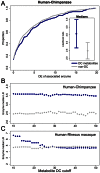Comparative metabolomics in primates reveals the effects of diet and gene regulatory variation on metabolic divergence
- PMID: 25069065
- PMCID: PMC4894427
- DOI: 10.1038/srep05809
Comparative metabolomics in primates reveals the effects of diet and gene regulatory variation on metabolic divergence
Abstract
Human diets differ from those of non-human primates. Among few obvious differences, humans consume more meat than most non-human primates and regularly cook their food. It is hypothesized that a dietary shift during human evolution has been accompanied by molecular adaptations in metabolic pathways. Consistent with this notion, comparative studies of gene expression levels in primates have found that the regulation of genes with metabolic functions tend to evolve rapidly in the human lineage. The metabolic consequences of these regulatory differences, however, remained unknown. To address this gap, we performed a comparative study using a combination of gene expression and metabolomic profiling in livers from humans, chimpanzees, and rhesus macaques. We show that dietary differences between species have a strong effect on metabolic concentrations. In addition, we found that differences in metabolic concentration across species are correlated with inter-species differences in the expression of the corresponding enzymes, which control the same metabolic reaction. We identified a number of metabolic compounds with lineage-specific profiles, including examples of human-species metabolic differences that may be directly related to dietary differences.
Figures





References
-
- Copeland L., Blazek J., Salman H. & Tang M. C. Form and functionality of starch. Food Hydrocoll 23, 1527–1534 (2009).
-
- Hohmann G., Robbins M. & Boesch C. Feeding ecology in apes and other primates: ecological, physical, and behavioral aspects. Vol. Cambridge (Cambridge University Press, 2006).
-
- Wrangham R. & Conklin-Brittain N. ‘Cooking as a biological trait'. Comparative biochemistry and physiology. Part A, Molecular & integrative physiology 136, 35–46 (2003). - PubMed
-
- Aiello L. C. & Wheeler P. The Expensive-Tissue Hypothesis: The Brain and the Digestive System in Human and Primate Evolution. Curr Anthropol 36, 199–221 (1995).
Publication types
MeSH terms
Grants and funding
LinkOut - more resources
Full Text Sources
Other Literature Sources
Miscellaneous

